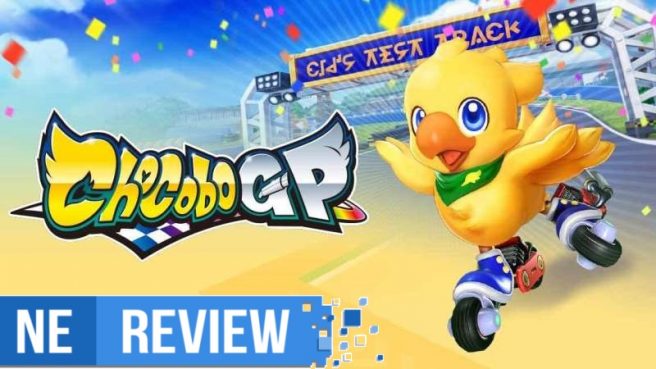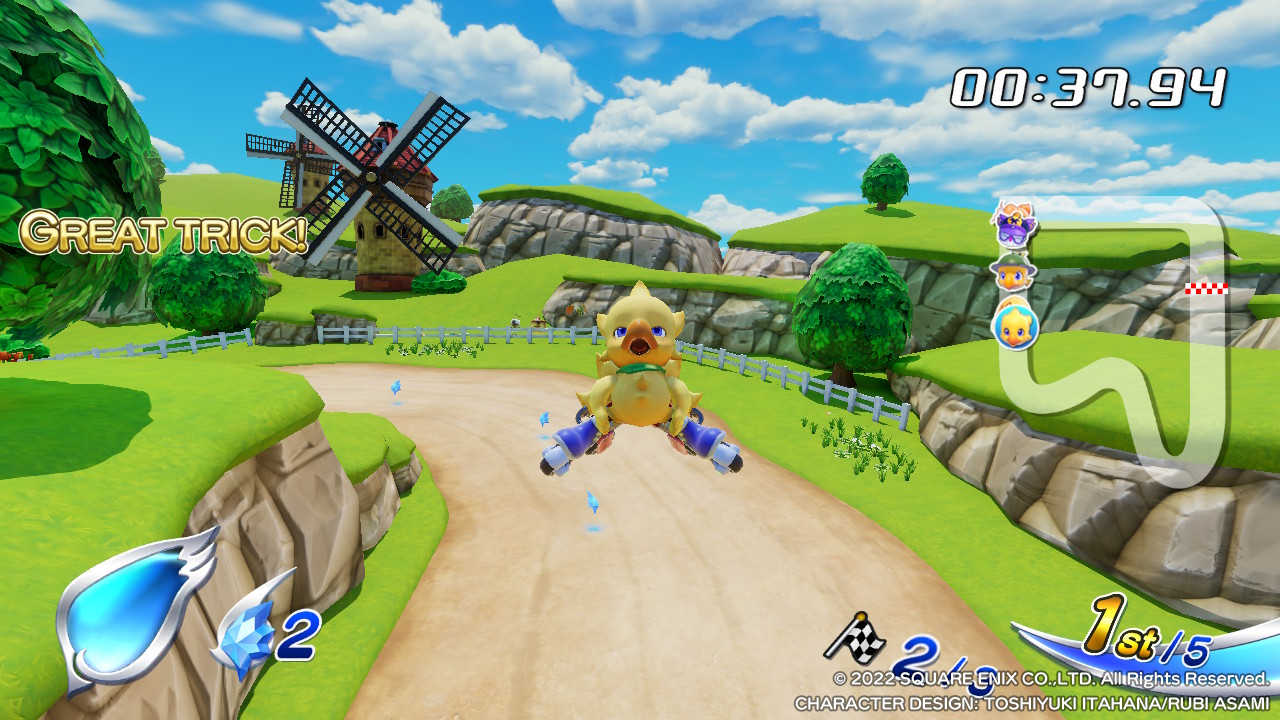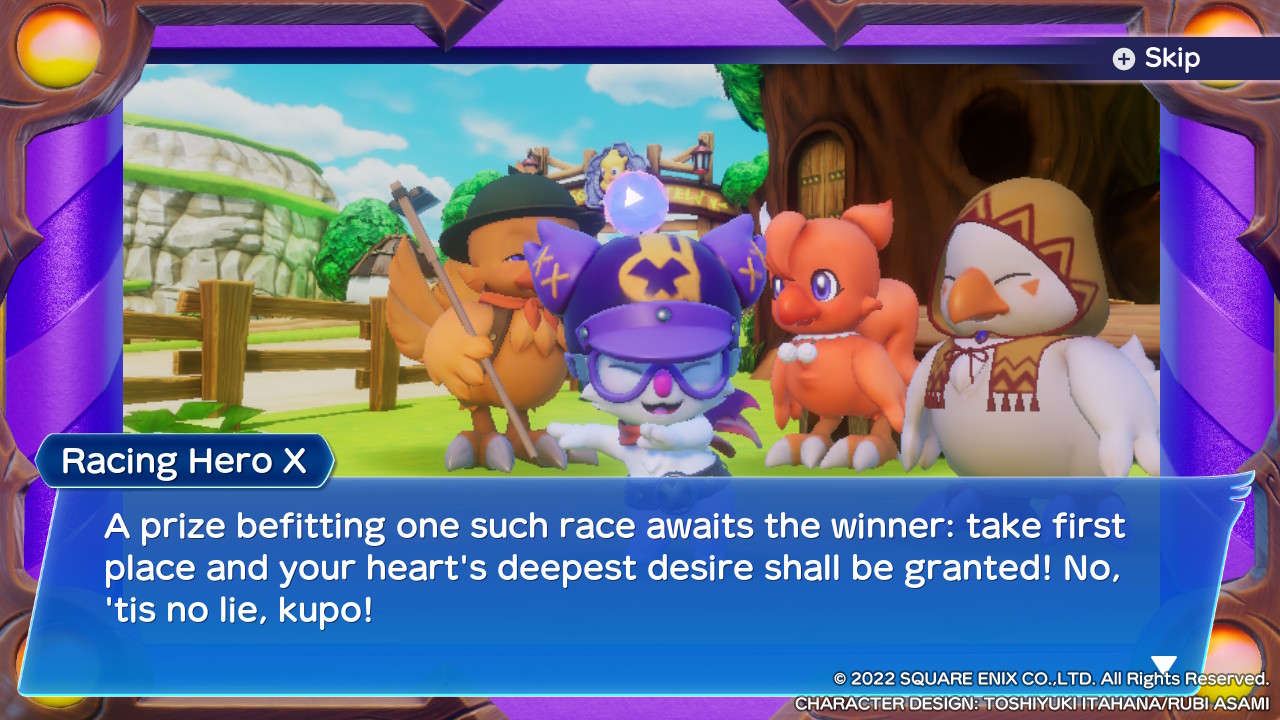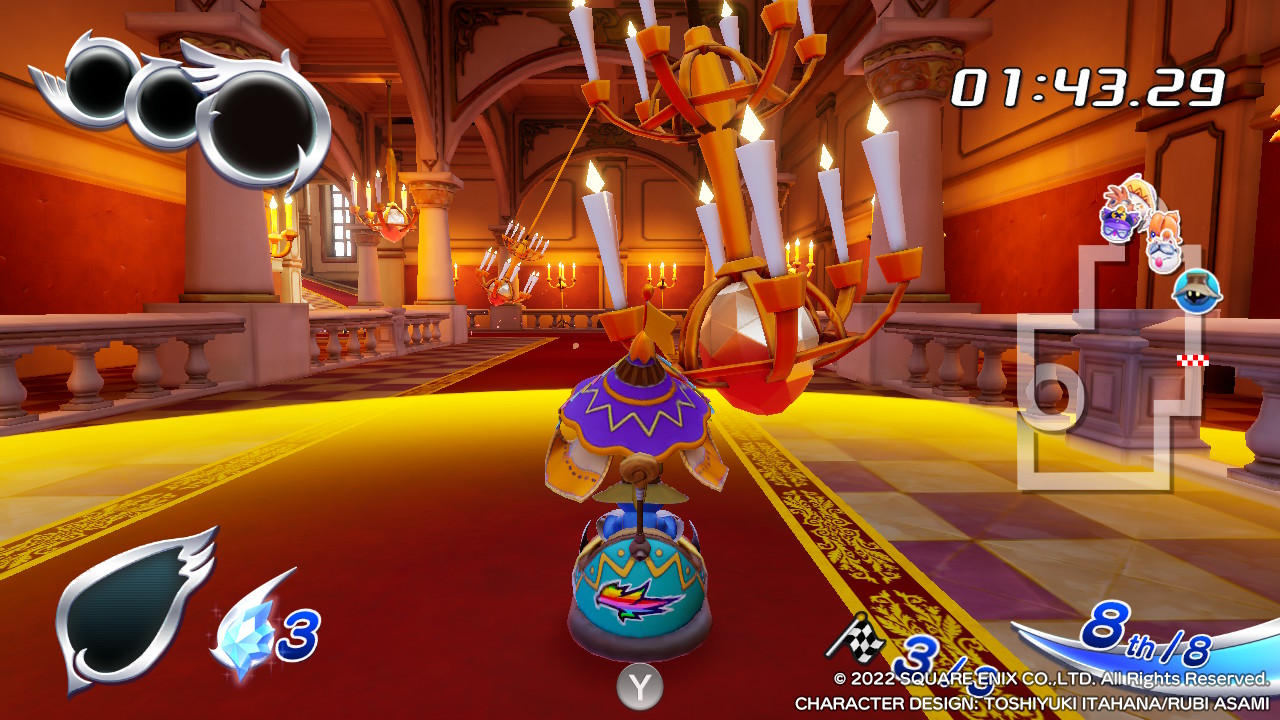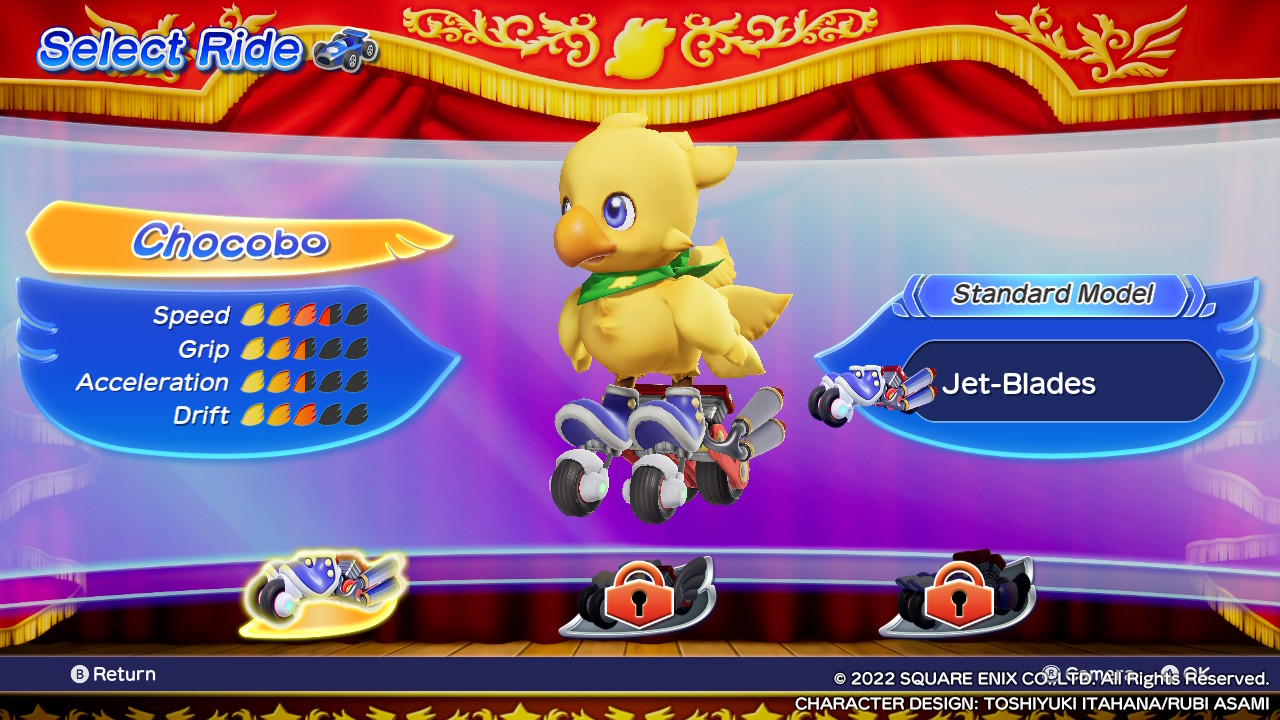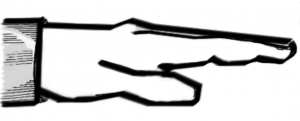[Review] Chocobo GP
System: Switch
Release date: March 10, 2022
Developer: Square Enix
Publisher: Square Enix
It takes some guts to release a Switch-exclusive kart racer on the same platform that houses the sales juggernaut that is Mario Kart 8 Deluxe; it takes even more guts to ape Nintendo’s kart racer so closely at a mechanical level that comparisons will be all but inevitable. Chocobo GP is the latest entry in Square Enix’s Final Fantasy-themed series of racing games, and it tries to set itself apart from the competition by including a fully-voiced story mode, a unique approach to power-ups, and oodles of Final Fantasy charm. Unfortunately, the slim track count and safe but unremarkable racing mechanics makes Chocobo GP feel inessential at best.
The story mode is likely where most Chocobo GP players will start, as completing it is key to unlocking tracks and characters in the rest of the game. It’s a relatively brief experience, consisting of nine chapters of one or two races apiece, all framed by a very silly story that’s presented as a stage play. Now, look – Final Fantasy games are known for their incredible storytelling, but I don’t think anyone is looking at Chocobo GP and expecting a magnum opus – which is good, because what’s here is at about the quality level of a mediocre Saturday morning cartoon. Basically, all you need to know going in is that a mysterious racer is hosting a tournament that promises the winner a single wish to be granted, and that Chocobo meets up with a bunch of different racers who all have their own reasons for wanting to win the tournament. There’s not much depth to it, although there are some chuckle-worthy lines here and there and occasional callbacks that longtime Final Fantasy games will pick up on. The whole thing is fully voice acted, too, which is worth mentioning as it does elevate the game’s presentation by a good degree. Still, since it’s all but mandatory to progress through the story mode to unlock most of Chocobo GP’s content, the developers do allow players to skip the story segments at the start of each chapter and simply jump right into races if they so choose.
In addition to the story mode, the game also features full online and local multiplayer, including a 64-player bracket tournament that pits everyone in a series of races. Revisiting the story mode will let players take on optional challenges for each track, and the game also has traditional four-track series of races and a time trial mode. Chocobo GP checks almost all the boxes from this perspective, and I can definitely see a small but passionate community forming around this game’s online modes – although servers were not active on at the time of writing, so I wasn’t able to test out the game’s full suite of multiplayer options.
Now, before I can give Chocobo GP some credit for what it does well, let me address the biggest problem I have with it: at launch, the game only has nine environments to race in. To be fair, most of these nine environments have two or even three different track layouts, but the low environment count meant that courses very quickly started feeling boring and familiar, moreso than with any other racer I’ve played. While it seems possible that more tracks will be added over time considering the structure of the game – something I’ll address later – I don’t feel like the current track selection is sufficient for a $40 release.
I was also generally disappointed at how little the tracks felt like Final Fantasy tracks, and how similar they felt aesthetically to courses from other kart racers. Chocobo GP was an opportunity to let players race through iconic locations like Midgar from Final Fantasy VII and Altissia from Final Fantasy XV, but instead, all we get are generic clones of existing courses from other games. For example, one of the first courses you’ll race on, Cid’s Test Track, not only looks very similar aesthetically to the stadium tracks we see in every Mario Kart game, but also lacks the flair and visual flourishes from the Final Fantasy universe that could have made it feel more unique. And that’s just one example – the Zozo track shares a strong motif with Neo Bowser City from Mario Kart 8 Deluxe, and the Gold Saucer course is almost identical visually to recent Rainbow Road courses. And look, I get it – Mario Kart 8 Deluxe has some incredible tracks, so of course other games will be inspired by them to some degree. What’s here, though, often feels like blatant rip-offs of existing tracks, and not even particularly good ones at that. The courses in Chocobo GP are also relatively flat and lacking in interesting terrain, and I didn’t find their individual layouts particularly interesting either.
Fortunately, the roster of playable racers fares a little bit better and will be more likely to appeal to Final Fantasy fans. While many of the game’s 23 unlockable characters are from some of the more niche corners of the series, there are some mainstays present here – Terra (from Final Fantasy VI), Vivi and Steiner from (Final Fantasy IX), and Cid (from basically every Final Fantasy game ever) are perhaps the most recognizable of the bunch. Most of the other racers are relatively minor characters, including a few different varieties of the eponymous Chocobo. While it may not be the most star-studded roster, I was super impressed with the attention to detail paid towards each character’s design, as well as the karts they drive. They’re all bursting with charm and personality in their animations, perhaps something best showcased when clicking in the joystick to taunt other racers on the track. And they all mostly drive different types of vehicles, too – Chocobo, for example, wear’s two engine-powered rollerblades on his feet that he uses to nimbly careen around corners, while another character drives what’s basically a tank.
While most of this is unlocked by way of the game’s story mode, Chocobo GP does contain an in-game store where it is possible to purchase characters, karts and cosmetics with both in-game currency and real-world money. In-game currency is doled out after every race, with more being awarded with higher podium rankings and if optional submissions are completed (like clearing a track within a certain time limit, for example). The in-game economy feels balanced enough in favor of players that most people won’t need to spend any extra cash to unlock what they want – I had unlocked all the game’s characters in a matter of hours – but I’m wary about the “live service” approach Chocobo GP is planning on taking in the future. The game will have seasons of content updates, with the first season pass introducing Cloud and Squall to the game, but with the caveat being that Cloud is exclusive to the Season Pass and that Squall can only be purchased with in-game currency. It’s understandable considering that Chocobo GP is launching a free version of the game alongside the full version, but it’s still not the type of model I like to see in these types of games.
All the racers in Chocobo GP not only look distinct but play distinctly too. It’s common in kart racers for different types of characters to handle differently on the track – heavier racers, for example, might drive slower than smaller racers but drift better than them – and Chocobo GP doesn’t break that tradition. Where it goes a step further, though, is by assigning each racer their own unique special ability that can be triggered strategically during the course of a race, potentially providing an advantage if used in certain scenarios. Some of these abilities are offensive, like launching a barrage of homing missiles down the course to obliterate racers ahead; others are defensive, such as brief invincibility. These special abilities are powered by an energy meter that fills slowly over the course of a race, meaning you’ll at most only have one or two opportunities to use it, and doing so at the right time can mean the difference between first and last place.
I also really enjoyed Chocobo GP’s approach to powerups – or Magicite if we want to use the in-universe phrasing – which I found to be overall more interesting than in any other kart racer I’ve played. You still collect them in the traditional way of smashing through containers placed along the course, but what sets these pickups apart is how unique some of them are, and how using them properly requires a bit more strategy than usual.
My favorite one is Swap, which basically places a portal in front of you that teleports you to another portal a little way up the track. This can be a huge help, but it can also backfire, potentially dropping you into a tight series of turns that you may not be ready for. This actually helps encourage learning the track layout itself, as it can then be deployed more intentionally to bypass tricky sections. It won’t always help – competitors can also drive through the portal before it closes, so if someone is tailing close behind you, you may not be able to increase your lead by much. But it can also be used against your enemies – if someone drives through the “out” portal instead of the “in” one, they’ll end up getting sent backwards on the course instead.
That’s just one of the game’s Magicite powerups, and the rest are just as intriguing. Some of them borrow aspects of their design from the Mario Kart games, but almost always with some sort of unique layer of nuance attached. For example, Chocobo GP’s take on Mario Kart’s Blue Shell is the appropriately named “Doom” Magicite – instead of targeting the player in first, it targets the player directly in front of you, and casts a curse on them that will eventually cause them to spin out to a complete standstill. Unlike the Blue Shell, though, it’s easier to avoid – once a racer has been cursed with Doom, they’ll have a limited amount of time to try and shake it off.
Another unique twist on the kart-racing formula is that if a racer collects multiple Magicite powerups, instead of carrying two instances of the same ability, both powerups will merge together to form one bigger, more potent version. It’s pretty satisfying to launch a homing fireball down the track at an enemy, but it’s way cooler to launch a GIANT fireball down the track, obliterating whoever dares drive in its path.
Speaking of driving, players of arcade racers will be right at home with the handling model in Chocobo GP. While karts don’t generally have the same feeling of momentum and weight to them as their appearances might otherwise suggest, they are in general all very responsive to even subtle movements. Drifting around corners can trigger a boost of varying power depending on how long it’s maintained, and hitting the shoulder button while jumping off a ramp can trigger a small boost upon landing as well. This is one part of the game that I’m glad has taken some inspiration from it’s genre contemporaries – if it ain’t broke, don’t fix it, right?
Really, that’s the mindset that seems to pervade most of what Chocobo GP is, for better or for worse. While it’s mechanically solid and has some interesting ideas, I rarely felt like I was playing something fresh or new. It just never quite reaches the full potential of what a Final Fantasy kart racer could be, mostly because it isn’t willing to lean harder into the unique settings and characters of those games, but also because it hesitates to venture beyond the gameplay rhythm that made Mario Kart such a big success.
The Verdict
Chocobo GP is a competent kart-racer that is generally fun to play and filled with charm, but is held back substantially by its slim environment list and unremarkable use of the Final Fantasy license. While I found the game’s racing to be basically just as tight and satisfying to execute as it is elsewhere, and I enjoyed the game’s creative takes on tried-and-trued powerups, there was very little about the overall Chocobo GP experience that felt like it would maintain my interest in the long-term compared to other racing games. Fans of kart racers should definitely consider checking it out – just don’t expect something revolutionary.
Chocobo GP copy provided by the publisher for the purposes of this review.
